Canning Oranges (Don’t Miss This Tip!)
This post may contain affiliate links. Read my full disclosure here.
Canning oranges is safe to do with water bath canning or steam canner. You can use this same technique for other citrus fruits. I included the tip I wish I knew before I got started with preserving citrus.
We recently found some nice looking clementines on sale and decided to give it a try. You can use your home canned citrus just like the store options. Enjoy them as a snack, or in salads or jello.

Table of contents
Preparing Oranges for Canning – The Easy Way
Start with firm, sweet oranges. Clementine mandarins are a good choice, because they are easy to peel. You want to remove the peel and the white part (the pith), which is bitter.
When I started researching, I ran into a number of people noting that the membranes got tough after canning. Other people said the fruit got bitter in storage. I suspect that this is why the commercial canned oranges are all in segments with no membranes.
Duncan and I sat down and manually removed the membranes our first time though. BUT – there’s a product called Pectinex that does the work for you. I wish I knew about this before we got started!
Using Pectin Enzymes to Remove the Membranes
You can use pectic enzyme for wine making to quickly remove the membranes.
All you need to do is peel the oranges and separate the segments. Place the peeled orange segments into cool water with pectin enzymes added. Use a ratio of 1/4 – 1/2 teaspoon (1-2 g) pectin enzymes to one quart (one liter) of water.
Let the orange segments sit for a few hours or overnight, and then rinse them clean. The pectin enzymes dissolves the pectin and makes it easy to remove by rinsing. Your cleaned segments are ready for canning.
If you don’t want to use Pectin Enzymes
If you don’t want to use pectin enzymes, peel and remove the pith by hand. You can hand peel the membranes, too, but it takes a lot of time. Some people can whole clementines in quart jars, but that leaves a lot of pith on the oranges.
I’d suggest trying small batches using different techniques to see which one you like best. The oranges are safe to can with or without the membranes removed.
Side note – if you want to freeze dry oranges in your home freeze dryer, I’d highly recommend removing the membranes. We tried some clementine segments with the membranes on, and they were in for a very long time and were still tacky.
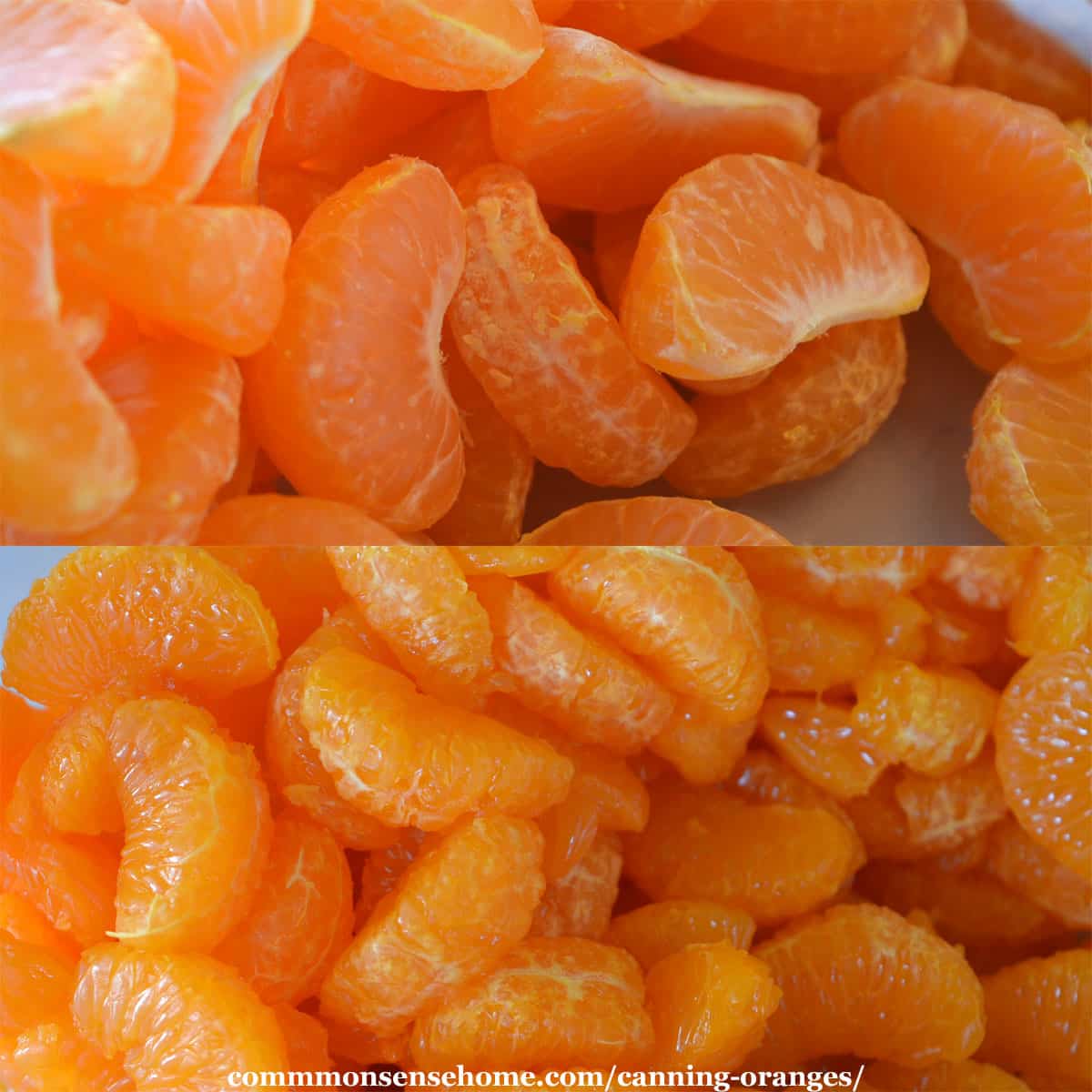
How to Can Oranges
Equipment:
- Water bath canner or steam canner
- Large pot (for mixing sugar syrup)
- Canning jars – quart, pint, or half pint jars
- Canning lids and rings
- Jar lifter
- Ladle
- Bubble remover
Ingredients:
- Oranges (or other citrus)
- Pectinex (optional)
- Water and sugar for syrup
Instructions:
If using Pectinex, prepare oranges in advance. Fill your canner and prepare jars and lids. Mix sugar and water to make a simple syrup and bring to boil.
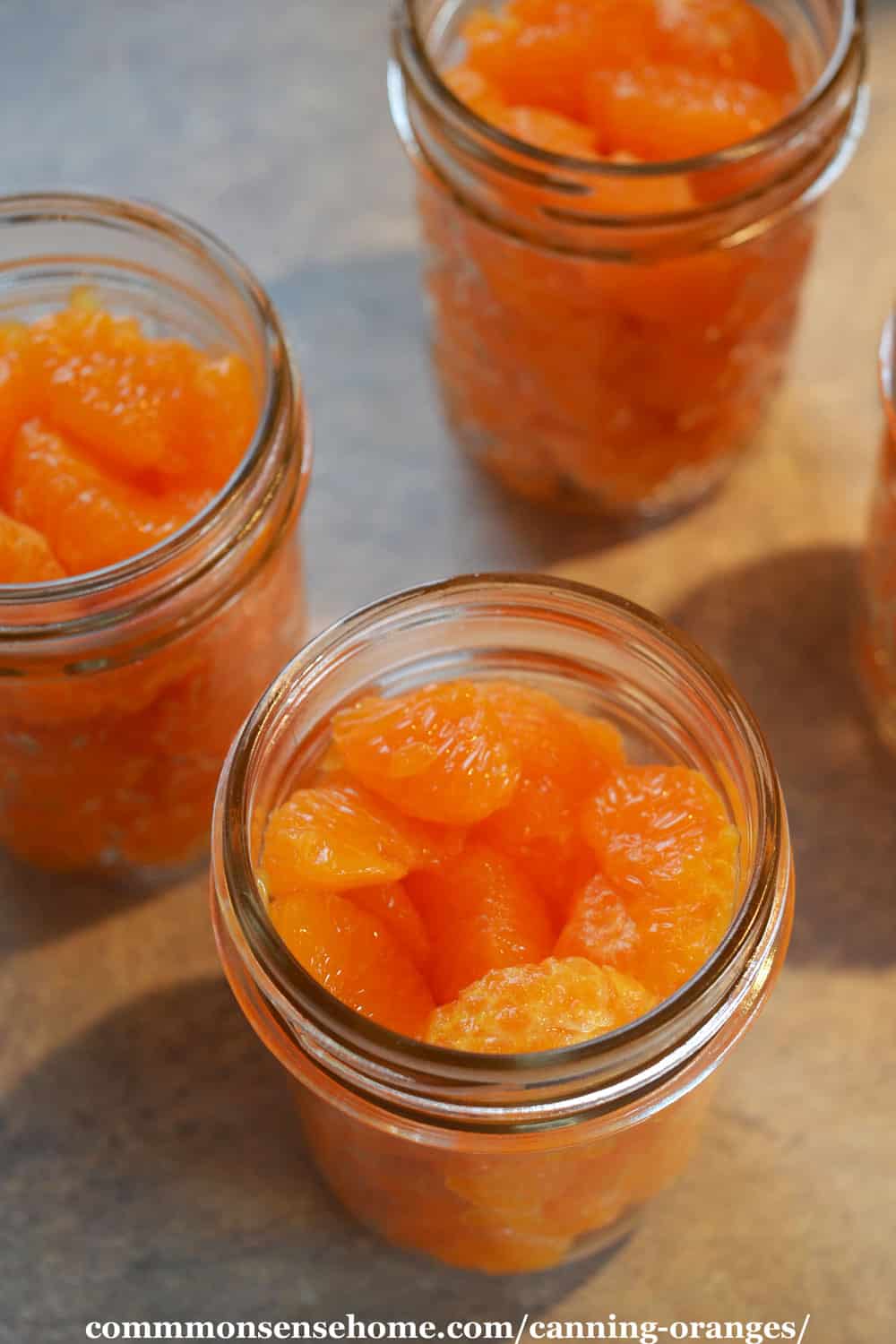
Pack orange segments into jars and cover with hot syrup, leaving 1/2 inch headspace.

Would you like to save this?
Remove air bubbles with chopstick or bubble remover. Wipe rims and place on jar lid and ring.
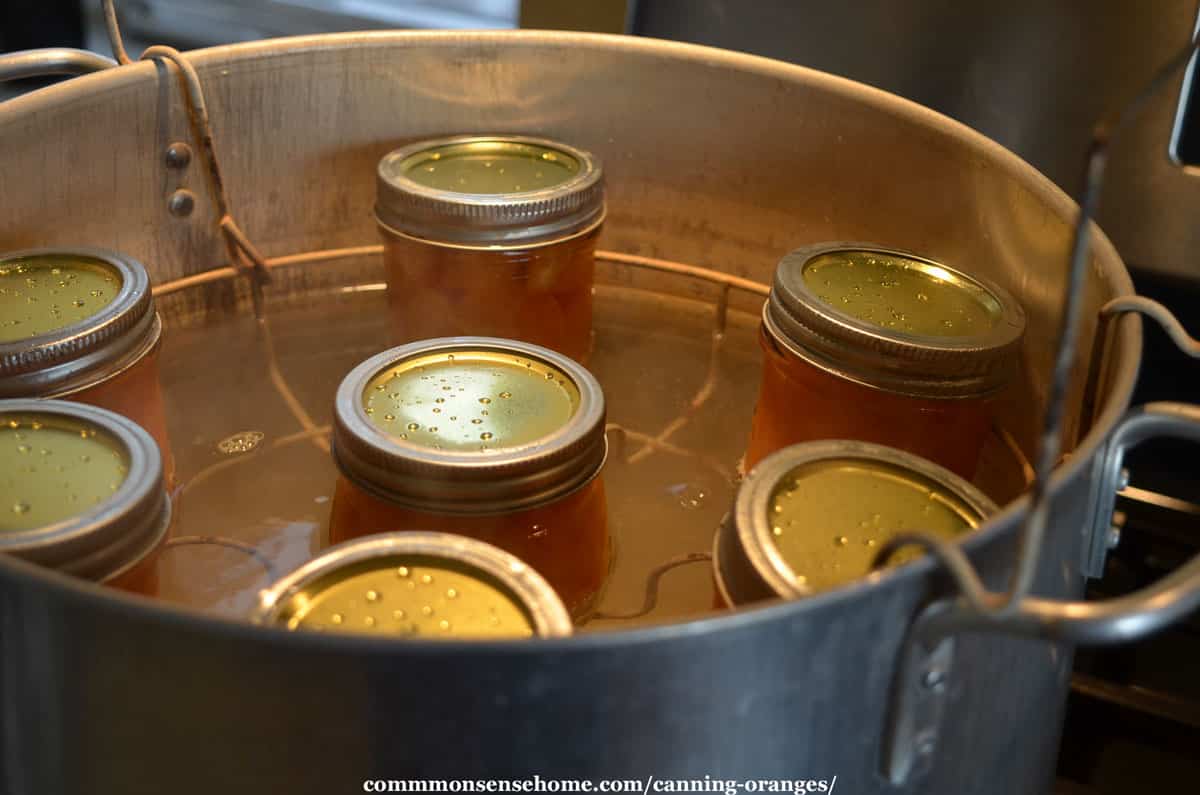
Process in a water bath canner or steam canner for 10 minutes. Adjust processing time as needed for higher altitudes. (15 minutes for 1001 – 6000 ft, 20 minutes for above 6000 ft.)
How Many Oranges do I need for Canning?
The National Center for Home Food Preservation estimates that you need around 15 pounds of oranges for 7 quarts. This mean you’ll need around 3-4 pounds for 7 half pints, or 6-8 pounds for 7 pints.
Ashley at Practical Self Reliance stuffs around 10 whole clementines in a quart jar. I like the half pint jars because we don’t grow citrus in our area. These are a treat for us, so a small jar is enough.
Making the Syrup (or Canning in Water)
You can use extra light, light, or medium syrup, or cover the oranges with boiling water. Honey syrup or spiced syrups are good, too. I don’t recommend plain water, as I’ll explain in a minute.
Granulated sugar syrup proportions
- Extra light syrup = 1 1/4 cups sugar and 5 1/2 cups water
- Light syrup = 2 1/4 cup sugar and 5 1/4 cups water
- Medium syrup = 3 1/4 cups sugar and 5 cups water
Honey syrups
- Light honey syrup = 1 1/2 cups honey and 4 cups water
- Medium honey syrup = 2 cups honey and 4 cups water
Tangerines have a pH of around 3.9 – 4.48. Oranges have a pH of around 4.02 – 4.34. Grapefruit pH is around 3.38 – 3.75. This means that all these citrus are safe for water bath canning without adding acid, because their pH is below 4.6.
With that acidity comes a certain amount of pucker power, especially if you leave the membranes on. The bitterness in any remaining pith comes out in storage, especially over time. Adding a little sweetener helps to counteract the bitterness.
When you pack fruit in plain water, the flavor tends to get washed out in storage. A little sugar also helps to keep the fruit firm, and to stabilize the color. We use a light syrup or extra light syrup.
Using a Pressure Canner
Pressure canning is not needed for fruits with a pH below 4.6. It tends to make foods softer and more cooked in flavor. If you want to pressure can oranges, there are guidelines on the National Center for Home Food Preservation.
How long do canned oranges last in storage?
Like most home canned goods, quality is best within the first year after canning. As time goes on, color and flavor starts to fade. Try to use your home canned goods within 2 years.
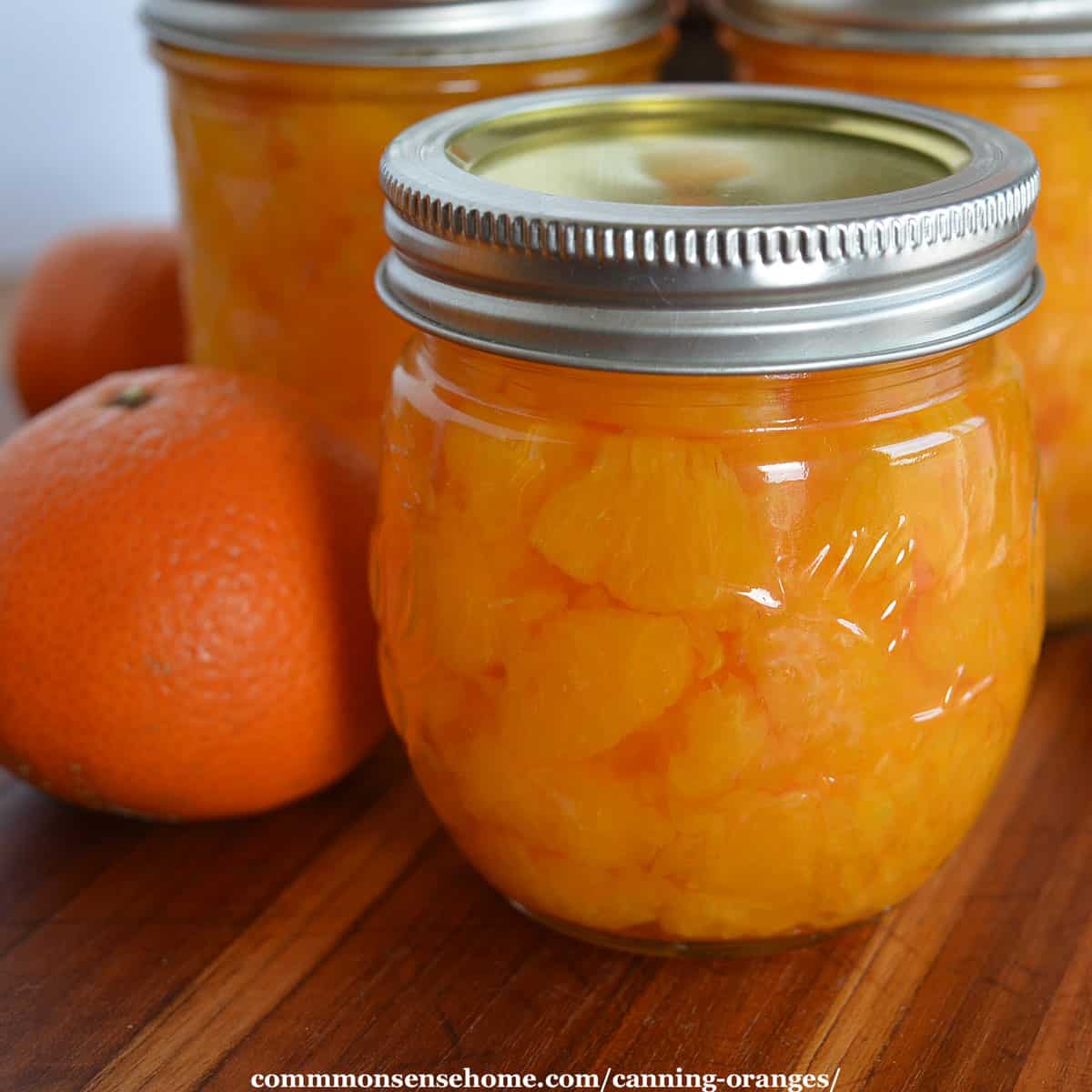
How are Mandarin Oranges Peeled for Canning in Factories?
Commercial processors use a combination of hot water, hand labor, and chemicals to remove the peels. membranes, and white pith before canning mandarin oranges. This youtube video shows the process at two different plants.
First, the fruit is scalded and peels removed. Then the segments are processed with lye and water, which dissolves the membranes and pith (the white stuff). After that, the oranges are rinsed in plain water and heat processed.
Thankfully, when canning oranges at home, we can use Pectinex to get the same results without the lye.
PrintCanning Oranges
Enjoy home canned citrus (without the lye bath of commercial oranges). Sweeten a little, or a little more – your choice.
- Prep Time: 10 minutes
- Pectinex rest time: 2 hours
- Cook Time: 10 minutes
- Total Time: 2 hours 20 minutes
- Yield: 7 half pint jars 1x
- Category: snack
- Method: Canning
Ingredients
- 3–4 pounds oranges (we used clementines)
- 2 1/4 cup sugar and 5 1/4 cups water for light syrup (see notes below)
- Pectinex Ultra SP-L (optional)
Instructions
If using Pectinex:
Peel the oranges and separate the segments. Place the peeled orange segments into cool water with Pectinex added. Use a ratio of 1/4 – 1/2 teaspoon (1-2 g) Pectinex to one quart (one liter) of water.
Let the orange segments sit for a few hours or overnight, and then rinse them clean.
If not using Pectinex, peel and segment oranges and remove as much white pith as possible.
- Fill your canner and heat the water. Prepare jars and lids. Dissolve sugar (or honey) in water to make a simple syrup and bring to boil.
- Pack orange segments into jars and cover with hot syrup, leaving 1/2 inch headspace.
- Remove air bubbles with chopstick or bubble remover. Wipe rims and place on jar lid and ring.
- Process in a water bath canner or steam canner for 10 minutes. Adjust processing time as needed for higher altitudes. (15 minutes for 1001 – 6000 ft, 20 minutes for above 6000 ft.)
- Turn off heat and let jars rest in canner for 5 minutes. Remove jars from canner and place on a towel on the counter top to cool completely.
- After jars have cooled, remove rings and check seals. Date and label jars and store in a cool, dark location. For best quality, use within one year.
Notes
Granulated sugar syrup proportions
- Extra light syrup = 1 1/4 cups sugar and 5 1/2 cups water
- Light syrup = 2 1/4 cup sugar and 5 1/4 cups water
- Medium syrup = 3 1/4 cups sugar and 5 cups water
Honey syrups
- Light honey syrup = 1 1/2 cups honey and 4 cups water
- Medium honey syrup = 2 cups honey and 4 cups water
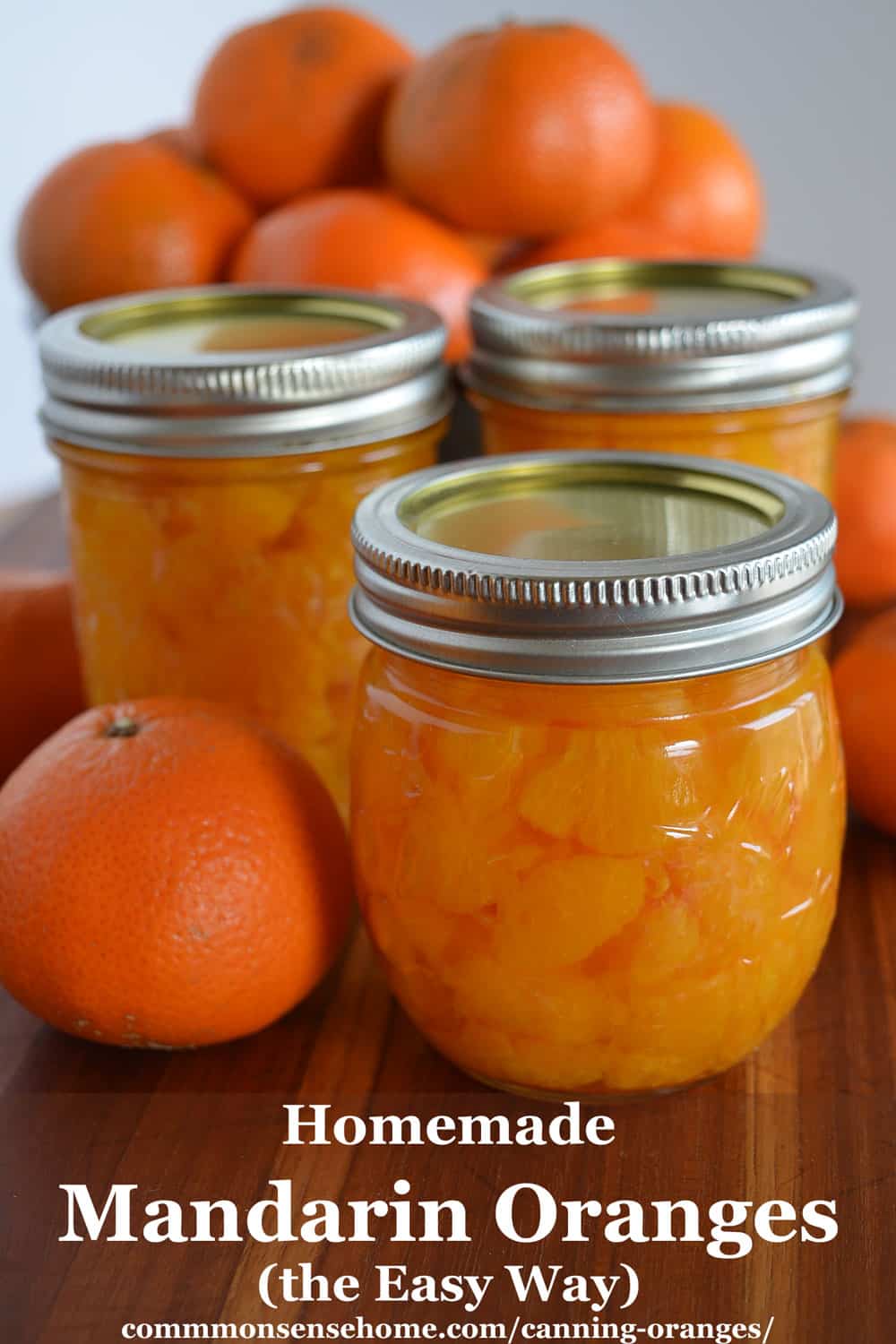
More Citrus Recipes
We have dozens of cooking and canning recipes on the site, including:

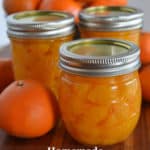

What a fantastic post! So thorough and well written! I’ve canned mandarin segments but didn’t like how LONG it took to scrape off all of tge white pith! Pectinex seems like a Godsend! Your post is tge first that actually gave an amount to use (I’ve read a bunch of others AND watched at least 4 videos). They all just add random amounts. My local grocery just had 3 pound bags of Clementines on sale for .99 cents! So the eight bags I bought are bound for jars tomorrow. 😉
Thanks for your positive feedback. Being generous with the pectin enzyme won’t hurt anything and may speed up the process, so if the membranes are stubborn, it’s fine to add more. I’ve noticed that some break down faster than others.
Never even thought about being able to can citrus fruit! We love Cara Cara oranges so I am now thinking that we could put up a few pints of those while we can still get them. I used to love those little tinned mandarins but have avoided commercial over sweetened tinned food for a long time. The thought of being able to put some up for myself has really made my day. Thanks!
Hi Laurie,
I was glad to see this article to prove to myself I wasn’t kind of looney. I made these last year after some internet searching for recipes and canning times. I make a fruit salad that my husband likes, using mandarin oranges. I was disgusted that the only cans I could find, at several grocery stores and different brands, all came from China. So I decided to make my own. I didn’t know about pectinex at the time either. I peeled all 15 pounds of oranges, then covered in cool water. I hand picked the pith off, which became easier in the oranges that had been in the water a few minutes. I water bath canned in the “very light” syrup in the Ball book and I got 13 pints. They tasted great and have maintained the flavor. I may still have a jar in the pantry. I will probably do it again very soon before all the mandarins are gone because I still don’t want to buy fruit from China!!
Did you check out the linked youtube video of the mandarin orange processing plants? The conditions are brutal.
Thanks for sharing your experience. I’ve been seeing a lot of articles and comments with people noting that their oranges got really bitter in storage, or the membranes got chewy, so I wanted to include an option for less labor intensive removal. I think like everything else, the quality of the fruit makes a HUGE difference, so if you start with a sweeter orange, you get a better end product.
We bought three bags of clementines, and end up giving most of one bag to the neighbor’s pigs, because that particular bag was so bitter.
I’ve not used Pectinex, but I have used pectic enzyme, a product sold for wine making. Quite a bit cheaper and works well (I’ve used it for prepping clementines for freeze drying).
Good to know. What ratio did you use?
Where do you get Pectinex?
You can order it online here – https://amzn.to/36w6Bhu .